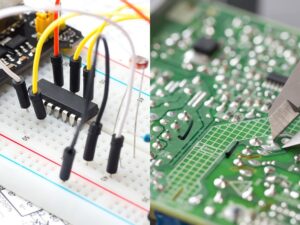Breadboard and PCB - What's the Difference?
2023-02-01It goes without saying that printed circuit boards are important for electronic devices. PCBs carry various electronic components that provide circuit connections and various complex functions for different devices.
When you learn to create circuits as a beginner, a breadboard would be a good choice.
Breadboards, also known as prototype boards, are solderless boards with one or both sides. Since the board has many small jacks, various electronic components can be inserted or pulled out at will as needed. Eliminating the need for soldering and saving time in circuit assembly, and the components can be reused, making it ideal for assembly, debugging and training of electronic circuits.
The common specifications of breadboard are 170 holes (35*47mm), 400 holes (85*55mm), 800 holes (165*55mm), etc.
Let's look at some of the differences between PCB and breadboard
1. Application
Breadboard is suitable for the development stage and can change at will according to the demand. PCB is used for final electronic product integration, manufacturing and assembly according to Gerber files.
2. Components
One obvious difference between breadboard and PCB is that the components on the breadboard do not need to be soldered and can be changed instantly, so it is also called solderless breadboard. While the components on the PCB need to be soldered, such as SMT technology and PTH technology, so the PCB is also relatively more stable.
3. Capacity
There is no doubt that the load-bearing capacity of the PCB is significantly higher than that of the breadboard. Breadboard connects components through wires, so the current-carrying capacity is minimal. At the same time, PCB can also add a variety of components, but in the breadboard can not be completed.
4. Type
Breadboard is rigid, while PCB has a variety of options, it can be rigid, flexible, rigid-flexible combination to meet the needs of different scenarios.
5. Complexity
Even the simplest PCB has a much more complex structure than a breadboard. Usually breadboard consists of distribution bus and holes, PCB's structure has at least substrate, copper layer, solder resist and screen printing.
6. Function
Breadboard supports components in a mechanical way, it does not perform electrical functions. PCB connects circuits in a mechanical and electrical way.
7. Appearance
The appearance of a breadboard is almost unchanging and relatively homogeneous. Whereas PCBs can be customized in various shapes, colors.
Choosing breadboards or PCBs?
If you are a circuit enthusiast or a beginner, breadboard can meet your needs. Breadboards can be easily prototyped and are relatively inexpensive. If you are looking for a long term, feature rich device, then a PCB is obviously the best choice.
Do you want to turn your breadboard prototype into a PCB?
After you have completed your development testing, you need to generate the Gerber files and Bom list for manufacturing your PCB. Then send these files to a professional PCB manufacturer, such as KingPCB, and we will carefully review your files and provide a quick quote, and then you can produce and assemble your PCB.
If you have any questions or want to get more information about PCB manufacturing, contact us now or send emails at sales@kingpcb.com




